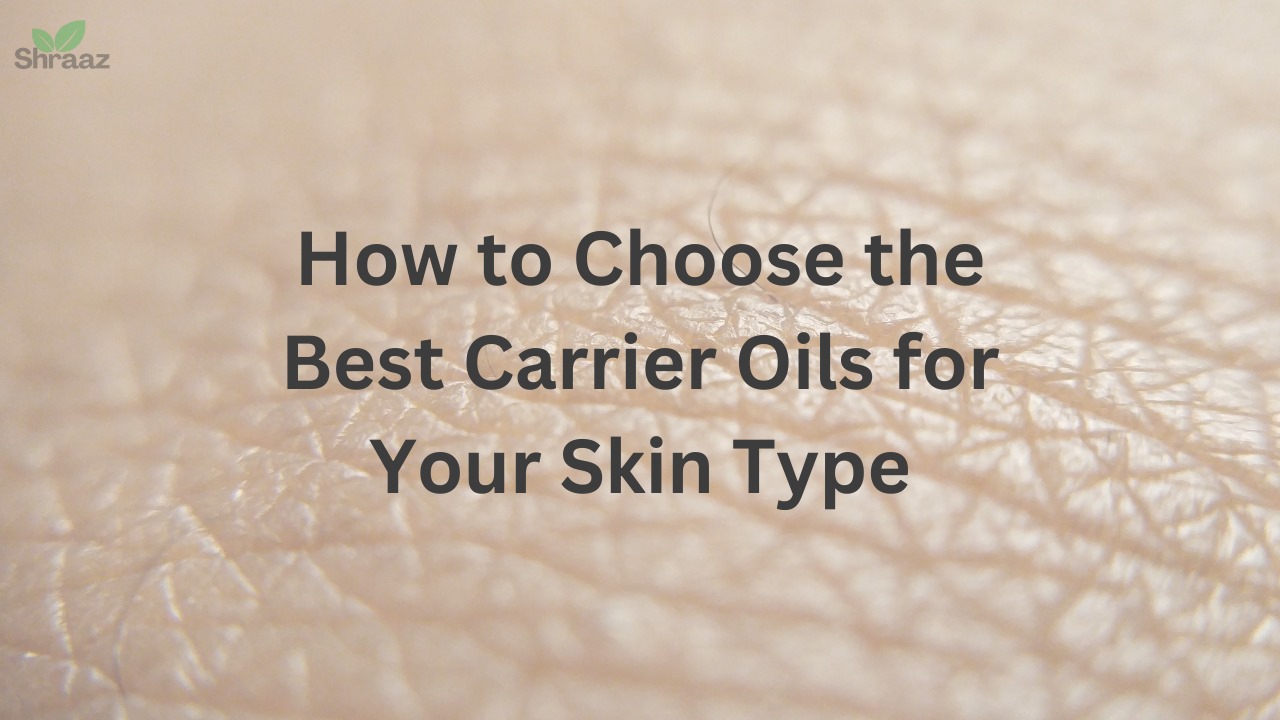Introduction
Carrier oils are essential components in skincare, providing a base for diluting potent essential oils and offering direct nourishment to the skin. These natural oils are derived from seeds, nuts, and kernels of plants, and each one has a unique composition of vitamins, fatty acids, and antioxidants that deliver various benefits. Choosing the right carrier oil for your skin type is crucial to maintaining balanced skin health. A mismatched oil can lead to clogged pores, irritation, or even exacerbate skin issues like dryness or acne.
In this article, we will guide you through selecting the best carrier oil for your skin type, taking into account factors like absorption rate, comedogenic rating, and nutrient profile. You’ll also learn how to make your own custom blends and store oils properly to extend their shelf life.
For a broader discussion of the overall Natural oils beyond just carrier oils, check out our Complete Beginner’s Guide to Using Natural Oils.
Understanding Skin Types
Before selecting a carrier oil, it’s important to understand your skin type and how different oils react to it. Each skin type has specific needs, and using an oil that complements these needs can make a significant difference in your skincare routine.
Common Skin Types
Here’s a breakdown of the most common skin types and their characteristics:
| Skin Type | Characteristics | Challenges |
| Oily Skin | Enlarged pores, shiny complexion, prone to acne and blackheads | Excess sebum production, clogged pores |
| Dry Skin | Rough, flaky, or tight skin; often feels dehydrated | Lacks moisture, may experience irritation |
| Combination Skin | Oily in the T-zone (forehead, nose, chin), dry or normal in other areas | Managing different textures in the same area |
| Sensitive Skin | Easily irritated by skincare products, prone to redness and inflammation | Finding products that are non-irritating |
| Normal Skin | Balanced sebum production, smooth texture, few imperfections | Maintenance of natural balance without causing issues |
How Skin Types React to Carrier Oils
Different skin types respond to oils based on their composition. For example, oily skin benefits from lightweight, non-comedogenic oils that help regulate sebum production, while dry skin needs richer, more emollient oils that deeply hydrate and repair the skin barrier. Sensitive skin requires oils with soothing, anti-inflammatory properties that don’t aggravate irritation.
Knowing your skin type is the first step to identifying the best carrier oil. In the next section, we’ll discuss key factors you should consider when choosing a carrier oil.
Key Factors to Consider When Choosing Carrier Oils
When selecting the best carrier oil for your skin type, it’s essential to consider various factors that can impact how the oil interacts with your skin. Here are the primary considerations:
1. Comedogenic Rating
The comedogenic rating of an oil indicates its likelihood of clogging pores, which is particularly important for acne-prone or oily skin. Carrier oils are rated on a scale from 0 to 5, where:
- 0-1: Non-comedogenic (unlikely to clog pores)
- 2-3: Moderately comedogenic (may clog pores for some people)
- 4-5: Highly comedogenic (likely to clog pores)
For example:
- Jojoba oil has a comedogenic rating of 1, making it ideal for oily or acne-prone skin.
- Coconut oil has a rating of 4, which may not be suitable for those with oily or combination skin but works well for dry skin.
2. Absorption Rate
The absorption rate of a carrier oil affects how it feels on the skin and how long it takes to fully absorb. Oils can be classified as:
- Light oils: Absorb quickly, leaving little to no greasy residue (e.g., grapeseed oil, hemp seed oil).
- Heavy oils: Take longer to absorb, leaving a protective layer on the skin (e.g., avocado oil, olive oil).
The right absorption rate depends on your skin type:
- Oily skin benefits from fast-absorbing oils to avoid adding more shine.
- Dry skin thrives on heavier oils that seal in moisture and prevent water loss.
3. Nutrient Profile
Carrier oils are packed with nutrients that directly benefit the skin. These include:
- Essential fatty acids: Such as omega-3 and omega-6, help to maintain the skin barrier and prevent moisture loss.
- Vitamins: Vitamin E, which is a powerful antioxidant, and Vitamin A (retinol), which helps with skin renewal.
For example, rosehip seed oil is rich in Vitamin A, making it great for aging or sun-damaged skin, while hemp seed oil is high in omega-3 and omega-6 fatty acids, which help balance oil production.
4. Skin Sensitivity and Allergies
Some carrier oils can cause allergic reactions or skin sensitivities, particularly for those with sensitive skin. Always perform a patch test before using a new oil. Common allergens in carrier oils include tree nut oils like almond oil, so if you have a nut allergy, you may want to avoid these.
5. Shelf Life
Carrier oils have different shelf lives, depending on their fatty acid composition and storage conditions. Oils high in polyunsaturated fats (e.g., hemp seed oil) tend to go rancid faster than those high in monounsaturated fats (e.g., olive oil). Proper storage, such as keeping oils in dark, airtight containers, can help prolong their shelf life.
Best Carrier Oils for Oily Skin
Oily skin tends to produce excess sebum, which can lead to clogged pores and breakouts. The best carrier oils for oily skin are lightweight, non-greasy, and non-comedogenic. They should help regulate oil production without causing congestion.
Recommended Carrier Oils for Oily Skin
| Oil | Key Benefits | Comedogenic Rating |
| Jojoba Oil | Mimics natural sebum, helps regulate oil production, absorbs quickly | 1 |
| Grapeseed Oil | High in linoleic acid, lightweight, helps reduce acne and inflammation | 1-2 |
| Hemp Seed Oil | Rich in omega-3 and omega-6 fatty acids, helps balance oil production, anti-inflammatory | 0 |
| Rosehip Seed Oil | Contains Vitamin A, brightens the skin, is anti-inflammatory, non-comedogenic | 1 |
How to Use Carrier Oils for Oily Skin
- Apply sparingly: Oily skin doesn’t need much oil. A few drops are enough to cover your entire face.
- Use at night: Apply oils in the evening to give them time to absorb without mixing with your daytime makeup or sunscreen.
In the next section, we will discuss the best carrier oils for dry skin and how they can help deeply hydrate and repair moisture barriers.
Best Carrier Oils for Dry Skin
Dry skin lacks natural moisture and can often feel tight, flaky, or irritated. The ideal carrier oils for dry skin are rich in essential fatty acids and provide long-lasting hydration. They should also help repair the skin’s moisture barrier, preventing water loss.
Recommended Carrier Oils for Dry Skin
| Oil | Key Benefits | Comedogenic Rating |
| Avocado Oil | Deeply moisturizing, rich in oleic acid, helps repair damaged skin barrier | 2 |
| Sweet Almond Oil | Gentle, packed with Vitamin E, smooths and softens dry skin | 2 |
| Olive Oil | Rich in antioxidants and fatty acids, helps lock in moisture | 2 |
| Baobab Oil | High in omega-3 and omega-6, boosts skin elasticity, helps with deep hydration | 2 |
How to Use Carrier Oils for Dry Skin
- Layering: Use heavier oils after applying a light moisturizer to lock in hydration.
- Body oils: These oils can also be applied to the body after a shower to seal in moisture and prevent dryness.
Summary Table for Dry Skin:
| Oil | Properties | Recommended Use |
| Avocado Oil | High in oleic acid | Night moisturizer or mask |
| Sweet Almond Oil | Vitamin E-rich | Daily face and body oil |
| Olive Oil | Antioxidant-rich | Body oil or hand treatment |
| Baobab Oil | Omega fatty acids | Deep hydration oil |
With this detailed overview of oils for dry skin, we’ve now covered both ends of the skin type spectrum. Next, let’s explore oils that work for combination skin, which can have both oily and dry areas.
Best Carrier Oils for Combination Skin
Combination skin can be tricky to manage since it often has both oily and dry areas, typically with oiliness concentrated in the T-zone (forehead, nose, and chin) and dryness on the cheeks or other areas. The ideal carrier oils for combination skin need to strike a balance between hydrating the dry areas and regulating oil production in the oily areas without clogging pores.
Recommended Carrier Oils for Combination Skin
| Oil | Key Benefits | Comedogenic Rating |
| Argan Oil | Lightweight, absorbs easily, balances oil production, rich in Vitamin E and fatty acids | 0 |
| Rosehip Seed Oil | Rich in Vitamin A (retinol) and C, helps with skin regeneration and brightening, non-greasy | 1 |
| Sunflower Oil | High in linoleic acid, lightweight and hydrating, non-comedogenic, rich in antioxidants | 0 |
| Squalane Oil | Mimics skin’s natural oils, fast-absorbing, lightweight, non-comedogenic, hydrates without clogging pores | 0 |
How to Use Carrier Oils for Combination Skin
- Targeted application: Apply lighter oils (like argan or rosehip) to the oily T-zone and richer oils (like sunflower or squalane) to drier areas like the cheeks. This way, you tailor your approach to each specific area.
- Layering: For daytime use, layer a light oil under a water-based moisturizer to keep hydration balanced throughout the day.
Summary Table for Combination Skin:
| Oil | Properties | Recommended Use |
| Argan Oil | Lightweight, balances oil | Daytime or nighttime use |
| Rosehip Seed Oil | Rich in vitamins A & C | Anti-aging, T-zone application |
| Sunflower Oil | High in linoleic acid | Daily moisturizer |
| Squalane Oil | Mimics natural sebum | Evening treatment or daytime use |
Combination skin requires flexibility, so alternating between oils as your skin changes (with weather, stress, etc.) is important to maintain a balance between oily and dry areas.
Best Carrier Oils for Sensitive Skin
Sensitive skin is prone to irritation, redness, and allergic reactions, making it essential to choose carrier oils that are gentle, soothing, and free from potential allergens or irritants. The best carrier oils for sensitive skin have anti-inflammatory and calming properties and are typically non-comedogenic to avoid triggering flare-ups.
Recommended Carrier Oils for Sensitive Skin
| Oil | Key Benefits | Comedogenic Rating |
| Chamomile Oil | Anti-inflammatory soothes irritation and redness, gentle and non-irritating | 1 |
| Calendula Oil | Anti-inflammatory helps calm redness and irritation, ideal for sensitive or inflamed skin | 1 |
| Squalane Oil | Non-comedogenic, mimics skin’s natural oils, highly moisturizing and gentle for sensitive skin | 0 |
| Jojoba Oil | Closely mimics skin’s sebum, hypoallergenic, soothing, and moisturizing without clogging pores | 1 |
How to Use Carrier Oils for Sensitive Skin
- Patch test: Always perform a patch test with new oils to ensure no allergic reactions or irritation occurs.
- Less is more: Use a minimal amount of oil and avoid mixing with essential oils unless you’re certain they won’t trigger a reaction.
Summary Table for Sensitive Skin:
| Oil | Properties | Recommended Use |
| Chamomile Oil | Anti-inflammatory | Soothing night oil |
| Calendula Oil | Redness-reducing | Day or night calming oil |
| Squalane Oil | Non-comedogenic, gentle | Hydration booster |
| Jojoba Oil | Hypoallergenic | Everyday use |
For sensitive skin, the key is to focus on oils that reduce inflammation and strengthen the skin’s natural barrier without causing additional irritation.
Best Carrier Oils for Normal Skin
If you have normal skin, you’re in the fortunate position of having a balanced complexion, meaning you can experiment with a broader range of carrier oils. The best carrier oils for normal skin will maintain the skin’s natural balance while providing hydration and nourishment to keep the skin looking healthy and radiant.
Recommended Carrier Oils for Normal Skin
| Oil | Key Benefits | Comedogenic Rating |
| Apricot Kernel Oil | Lightweight, fast-absorbing, rich in Vitamin E, balances hydration | 2 |
| Marula Oil | High in antioxidants, promotes smooth and radiant skin, anti-aging properties | 3 |
| Baobab Oil | Rich in essential fatty acids, boosts skin elasticity, hydrates without being too greasy | 2 |
| Jojoba Oil | Mimics skin’s natural sebum, balancing and hydrating | 1 |
How to Use Carrier Oils for Normal Skin
- Daily use: Normal skin can tolerate most oils, so you can apply them daily, either on their own or mixed with a moisturizer.
- Customize for seasonal needs: You might need a richer oil like baobab during colder months and a lighter oil like apricot kernel in the summer.
Summary Table for Normal Skin:
| Oil | Properties | Recommended Use |
| Apricot Kernel Oil | Vitamin E-rich, lightweight | Daily face moisturizer |
| Marula Oil | Antioxidant-rich, smooth | Anti-aging oil for day/night |
| Baobab Oil | High in fatty acids | Deep hydration |
| Jojoba Oil | Balancing, light texture | Daytime or nighttime use |
For normal skin, the goal is maintenance—using oils that keep the skin balanced, nourished, and radiant.
DIY Carrier Oil Blends
Blending carrier oils allows you to customize a solution tailored to your skin’s unique needs. Whether you want to address multiple concerns (such as dryness and oil control) or create a targeted treatment for acne or anti-aging, blending oils can enhance their effectiveness.
Customizing Carrier Oil Blends for Your Skin
- For oily skin: Blend light oils like jojoba and grapeseed with a few drops of essential oil like tea tree for added acne-fighting properties.
- For dry skin: Combine rich oils like avocado and sweet almond for a deeply hydrating mix, adding lavender essential oil for calming effects.
- For combination skin: Use rosehip seed oil with a touch of argan oil to balance both dry and oily areas.
- For sensitive skin: Blend soothing oils like chamomile and squalane for an ultra-gentle mix that calms irritation and hydrates.
Example Blends:
| Blend Type | Ingredients | Purpose |
| Oily Skin Blend | Jojoba oil + Grapeseed oil + Tea tree EO | Control oil, reduce breakouts |
| Dry Skin Blend | Avocado oil + Sweet almond oil + Lavender EO | Deep hydration, calm dry skin |
| Combination Skin Blend | Rosehip oil + Argan oil | Balance oil production, hydrate dry areas |
| Sensitive Skin Blend | Chamomile oil + Squalane | Soothe irritation, hydrate gently |
Safety Tips for Blending Oils
- Patch testing: Always patch test your blend on a small area of skin, especially if using essential oils.
- Correct dilution: Essential oils should be used at a dilution of about 1-2% in a carrier oil to avoid irritation.
How to Properly Store Carrier Oils
Carrier oils can degrade over time if not stored properly, which can reduce their effectiveness and lead to rancidity. Proper storage helps preserve the nutrient profile and ensures your oils remain fresh for as long as possible.
Shelf Life of Common Carrier Oils
The shelf life of an oil depends on its composition. Oils with a higher level of polyunsaturated fats tend to have shorter shelf lives, while oils rich in monounsaturated fats or saturated fats can last longer.
| Oil | Shelf Life | Storage Tips |
| Jojoba Oil | Up to 5 years | Store in a cool, dark place |
| Grapeseed Oil | 6-12 months | Refrigerate after opening |
| Avocado Oil | 1-2 years | Keep it in an airtight container |
| Rosehip Seed Oil | 6-12 months | Refrigerate to extend shelf life |
Best Practices for Storing Carrier Oils
- Airtight containers: Use dark, airtight glass bottles to reduce exposure to air and light, which can degrade the oil.
- Cool, dark places: Store oils in a cool, dark area, like a pantry or a drawer. For oils with shorter shelf lives (e.g., rosehip seed oil), consider refrigeration.
- Avoid contamination: Use clean, dry utensils when handling oils to prevent bacterial contamination.
Conclusion
Choosing the best carrier oil for your skin type can dramatically improve your skincare routine. By understanding your skin type and the unique properties of various oils—such as comedogenic rating, absorption rate, and nutrient profile—you can select oils that will nourish, balance, and protect your skin.
Whether you have oily, dry, combination, sensitive, or normal skin, there’s a carrier oil that will work for you. Additionally, blending oils allows you to create customized solutions tailored to your specific skincare needs. Proper storage is also key to maintaining the integrity of your oils, ensuring they provide the best results over time.
By carefully selecting and using carrier oils, you can unlock the full potential of natural skincare, achieving healthy, glowing skin that looks and feels its best.




